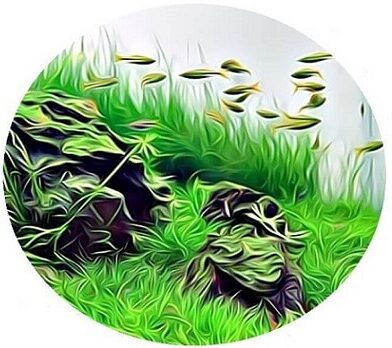Water Hardness
Introduction
Learn about how to measure, reduce or raise your water hardness KH and GH.
It also helps plant growth.
Do you want to know What is GH in Aquarium? KH of Water? General hardness aquarium? Stay with me.
Table of Content
– Difference between KH and GH
– Online Calculator: dGH to ppm Conversion
– Online Calculator: ppm to dGH Conversion
– What is the ideal GH General Hardness?
– What is the ideal GH for a planted aquarium?
– What is the ideal KH?
– What is the ideal KH for a planted aquarium?
– Is high KH bad for fish?
– How to reduce the water hardness?
– How to raise water hardness?
– How to convert from dGH to ppm?
– How to convert from ppm to dGH?
– Intro on General Hardness GH
– Intro on Total Alkalinity KH
– How to measure water hardness
– How to know which water my fish need?
Aquarium Water Hardness KH and GH
Contrary to what you might think, you can manipulate and adjust your water hardness. I have very hard water where I live, and I decided to keep it at about 14 dGH, so I took some actions and now have it. Stay with me and learn more about this.
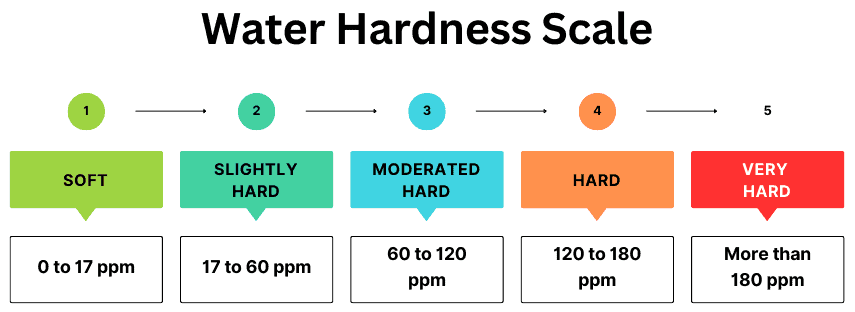
If you just want to convert your water hardness level from dGH to ppm or vice versa, you can use our online calculator:
Online Calculators Click and Convert
By the way, you can test your water hardness using, for example, this kit.
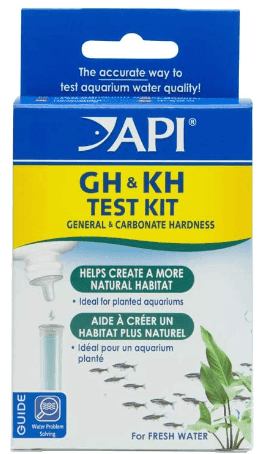
I made this short video where I show you all the steps.
Water Hardness is measured in:
• Degrees GH for the “General Hardness” (how much magnesium and calcium you have in your tank water)
• Degrees KH for the “Carbonate Hardness” or “Total Alkalinity” or “Buffering Capacity” (how much carbonate and bicarbonate ions you have in your tank water).
I know, confused, right? Stay with me and you will understand soon.
Difference Between KH and GH
The difference between KH and GH is that KH measures carbonate hardness (CO3 and HCO3), and GH measures Calcium and Magnesium (Ca and Mg). You can have a high KH and low GH or vice versa. They are definitively different things.
It is common and acceptable to say I have “hard water” or “my water is soft” which usually means that both GH and KH are high or low, but to be precise, we should quote GH and KH values separately.
When it is mentioned that a fish requires “Soft Water,” it generally means that the plant needs low KH, not low GH.
KH measures your aquarium’s water carbonate hardness.
Having a good level of KH means you are protecting your fish, snails, and shrimps against sudden pH fluctuations that could cause their death (pH crash).
GH (General hardness) measures the number of dissolved calcium and magnesium ions.
GH is essential for the growth of certain fish species. It helps their muscle development, organ function, and breeding of certain fish species.
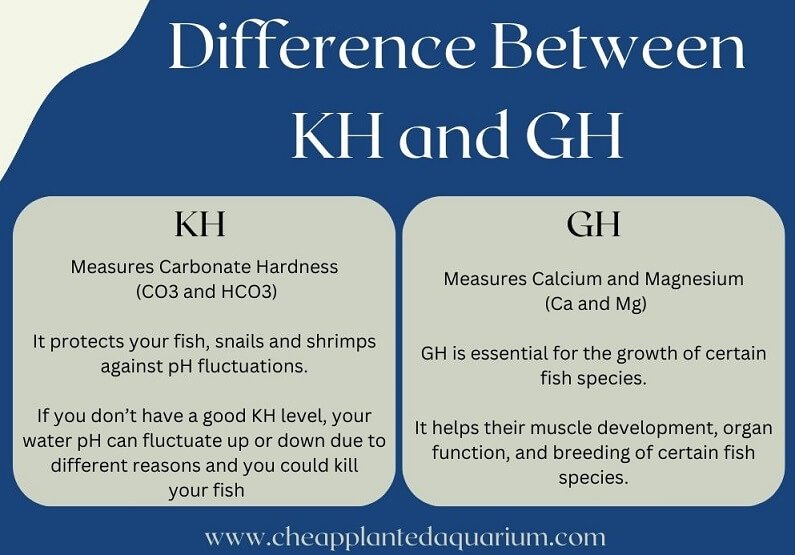
Water Hardness KH GH frequent questions and answers
What is the ideal GH General Hardness for a freshwater aquarium?
In general between 3 to 15 degrees dGH, but read more here as it depends on the fish you have or will have and some other things. Don’t forget about pH and ammonia – learn more here.
What is the ideal GH General Hardness for a planted aquarium?
In general between 3 to 5 degrees dGH, but read more here as it depends on the fish you have or will have and some other things.
What is the ideal KH for a freshwater aquarium?
In general, between 4 to 12 degrees dKH, but read more here as it depends on the fish you have or will have and some other things. Don’t forget about pH – learn more here.
You can find a KH Scale table here.
What is the ideal KH for a planted aquarium?
In general, between 4 to 7 degrees dKH but read more here as it depends on the fish you have or will have and some other things. Don’t forget about pH and ammonia – learn more here.
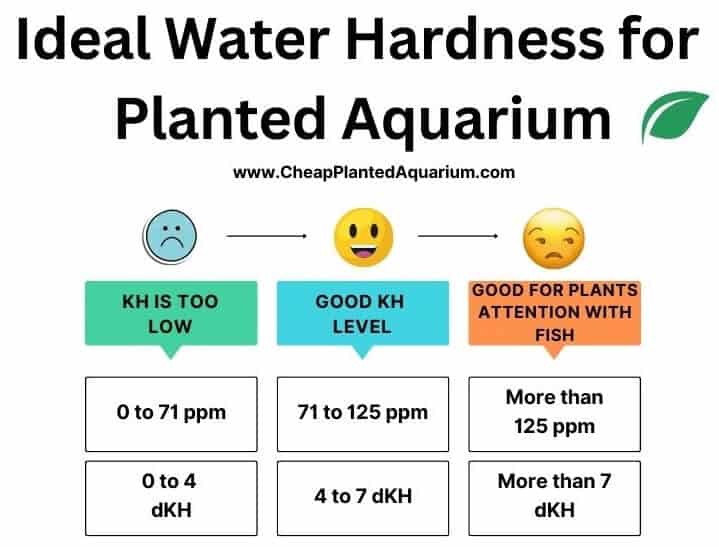
You can find a KH Scale table here.
Is high KH bad for fish?
Generally speaking, a high KH is good for fish, invertebrates, and plants because, as I will explain later, it avoids fast pH changes (pH crash). Certain fish species prefer low, medium, or high KH, so you should always research before changing your KH level or buying new fish.
How to reduce the KH and GH hardness (Hard Water or Water Hardness) in a freshwater aquarium?
How to lower water hardness in aquariums is a common question. You can use water softener pillows, distilled water, or RO water. Read more about these options here.
Attention, if you are trying to reduce your aquarium’s water hardness but it keeps raising, read this article.
Watch this video to see how a water softener pillow works.
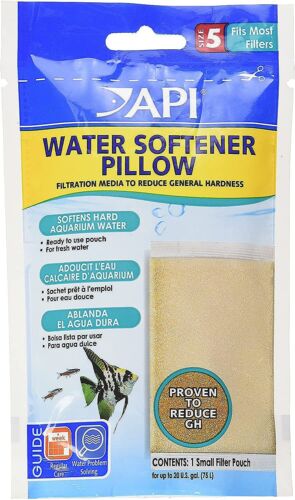
How to raise KH and GH hardness (Hard Water or Water Hardness) in a freshwater aquarium?
The easier and more controlled way to raise your hardness is using tap water during your water changes, mixing it with RO water (if your tap water is hard), or using Alkaline buffers.
Alkaline Buffers are safe and you can easily reach the desired level as they come with detailed instructions about how much you should use to raise 1 or 2 or 3 degrees. Read more about these options here
How to convert from dGH to ppm
Most water test kits give you the result in dGH, and sometimes you want to know the value in ppm. To convert it, multiply the dGH number by 17.9 to obtain the equivalent ppm.
For example: If you have 2 dGH, multiply 2 by 17.9 , which is 35.8 so 2 dGH is the same as 35.8 ppm
I made this online dGH to ppm calculator to help you.
It is high? Learn how to reduce here.
Do you want to raise it? Check how to here.
How to convert from ppm to dGH
Sometimes you want to convert your water hardness level from ppm to dGH. In this case, divide the ppm number by 17.9 to obtain the equivalent in dGH.
For example: if you have 35.8 ppm and you want to know this number in dGH you should divide 35.8 by 17.9 and you will find 2. So 35.8 ppm is the same as 2 dGH.
I made this online ppm to dGH calculator to help you.
It is high? Learn how to reduce here.
Do you want to raise it? Check how to here.
General Hardness (GH)
When measuring your water’s GH you are measuring the amount of calcium (Ca++) and magnesium (Mg++) ions in the water.
GH is essential for your fish and invertebrate’s development, organ function, and breeding.
Do you want to know the difference between GH and KH? Here.
In general, 3 to 15 dGH is recommended, but if you are working on a planted tank, 3 to 5 degrees dGH is a good level – wait, wait to start fighting with your water. Do you really need to change it? Check if your fish and livestock really need this change because many of them can adapt to your current water. Jump to this topic and learn how to check which water type your fish need.
Shrimp are especially sensitive to GH.
Cichlids and livebearers, for example, prefer hard water.
Aquatic plants benefit from calcium and magnesium dissolved in your water, this means GH is useful for them.
Most water test kits give you the result in dGH and sometimes you want to know the value in ppm. To convert it, multiply the dGH number by 17.9 to obtain the equivalent ppm.
For example: If you have 2 dGH, multiply 2 by 17.9 which is 35.8 so 2 dGH is the same as 35.8 ppm
I made this online dGH to ppm calculator to help you
Sometimes you want to convert your water hardness level from ppm to dGH. In this case, divide the ppm number by 17.9 to obtain the equivalent in dGH.
For example: if you have 35.8 ppm and you want to know this number in dGH you should divide 35.8 by 17.9 and you will find 2. So 35.8 ppm is the same as 2 dGH.
It is high? Learn how to reduce here.
Do you want to raise it? Check how to here.

Total Alkalinity (KH)
What is KH? Why it is so important?
KH is a water property defined by the quantity of bicarbonates, carbonates, and hydroxides dissolved in it. If your aquarium water has a lot of bicarbonates, carbonates, and hydroxides, then your water has a high KH.
KH is essential and should be monitored due to its capacity to neutralize acid components. As an example, if you throw an acid substance on your tank water, these bicarbonates, carbonates, and hydroxides will react with it and will neutralize an amount of the acid component avoiding the acidification
of your aquarium water.
Do you want to know the difference between GH and KH? Here.
Why is this important? Let’s say you are refilling your tank with TAP water, and this water is very acid, or maybe you found a beautiful rock, and you add it to your tank, but you didn’t know it has a lot of minerals that turn the water more acidic.
If you have a good level of KH, all those carbonates will react with the acid component, neutralizing it and avoiding a drastic pH variation (pH crash) which could kill your fish.
This is why the KH of your water is also called the “buffering capacity”. This property is crucial because it helps to avoid fast changes in the water pH, which is not good for fish.
The “U.S. Department of the Interior has a good article about KH“.
Having a good KH level means that you can keep your pH level fairly stable.
So, in resume, having a good level of KH helps to protect against dangerous pH fluctuations (pH crash).
In general, try to keep your KH between 120 and 180 ppm (4 to 12 dKH)
Most water test kits give you the result in dGH, and sometimes you want to know the value in ppm. To convert it multiply the dGH number by 17.9 to obtain the equivalent ppm.
For example: If you have 2 dKH, multiply 2 by 17.9 which is 35.8 so 2 dKH is the same as 35.8 ppm
Sometimes you want to convert your water hardness level from ppm to dKH. In this case, divide the ppm number by 17.9 to obtain the equivalent in dKH.
For example: if you have 35.8 ppm and you want to know this number in dKH you should divide 35.8 by 17.9 and you will find 2. So 35.8 ppm is the same as 2 dKH.
How to measure water hardness.
To measure the hardness of your aquarium water, you will need to use a test kit like this one. Test kits are available at Amazon or pet stores and can be purchased for as little as $15. They are an excellent way to test your water hardness.
These kits are easy to use and come with clear instructions. I recorded this small video to show you all the necessary steps.
How to reduce water hardness.
Here you have some of the most common ways to reduce water hardness.
Attention, if you are trying to reduce your aquarium’s water hardness but it keeps raising, read this article.
- Reverse Osmosis systems are a group of filters that remove all traces of minerals from tap water. You can use RO water when making your aquarium or during water changes. You can buy RO water in most of the local fish stores or you can buy your own system. I like to use this RO kit from AquaticLife – it costs about ($70).
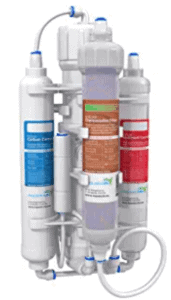
RO water will slowly reduce your GH and KH in the same time.
- Distilled Water can also be used. You can buy small quantities in Walmart or other grocery stores. See this link for an example. Check its pH before you use it and adjust accordingly. You can use it during water changes or when building your tank. Distilled water will slowly reduce your GH and KH in the same time.
- You can use water softener pillows to reduce your GH. They are resin bags that remove Calcium, Magnesium, and Soluble Heavy Metals, including Iron and Copper. They don’t add harmful chemicals to your water. This is the one I have used before. Attention: they work very fast. Check your GH daily or even twice daily while using them so you can remove the pillow when you reach the desired level.
Watch this video to see how the water softener pillow works
How to raise your water hardness
How to raise kh in aquarium?
My tap water is very hard, so I mix it with the RO water I get from my RO System, and I use it during my water changes (1 gallon of tap water for every 10 gallons of RO water). Test your tap water and if you find out it has high KH or GH, you can use it during your water changes too.
Another option is to use Seachem Alkaline buffer. They are safe and work well. Their directions tell you how much you should use to increase, for example, 1 unit of your hardness. It’s easy to understand and use.
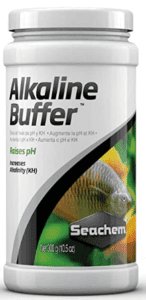
Test your GH and KH before and after the water change to see when you reached your desired levels.
How to know which water my fish need?
You will need to do some research on Google but I can guide you on the steps.
- Open Google (www.google.com)
- Type something like “abcdef and fish and types of waters” replacing the “abcdef” with your fish name.
Like here, for example
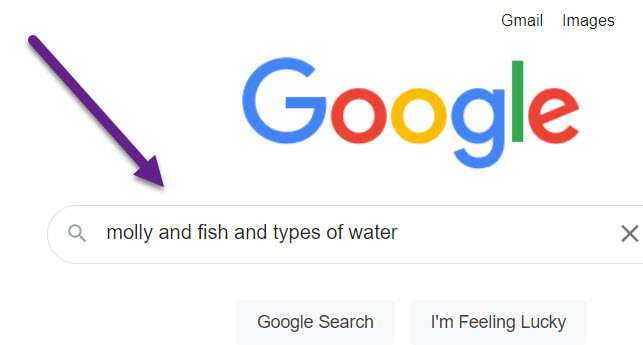
Open the page and look for something saying the pH this fish needs, temperature, and also Water Hardness.
See this example:
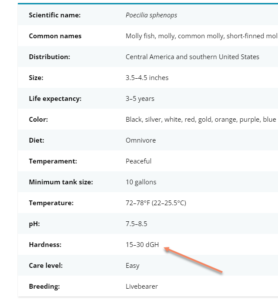
I suggest you research at least two sites.
Conclusion
The GH and the KH levels of your aquarium water are essential factors in determining the health of fish and plants.
You should always know the GH and KH of your tank when buying fish or invertebrates and double-check if they are compatible. Choose your livestock based on your water or the livestock you want and adjust your water accordingly.
If you live in the United States and if you want to know how is your TAP Water, our USGS has a very good page with a lot of good information (here).
References
For this article, I used the “USGS – Water Science School website“, “Aquarium Water Quality: Total Alkalinity and Hardness from FDACS – Florida Department of Agriculture” and also my 12 years of experience with fresh water tanks.
U.S. Department of the Interior Credit: James M. Omernik, Glenn E. Griffith, Jeffrey T. Irish, and Colleen B. Johnson
What is Next
I suggest you to have a look in my “Water Parameters” article to learn about pH, Ammonia, Nitrites, Nitrates and much more. Click here.
